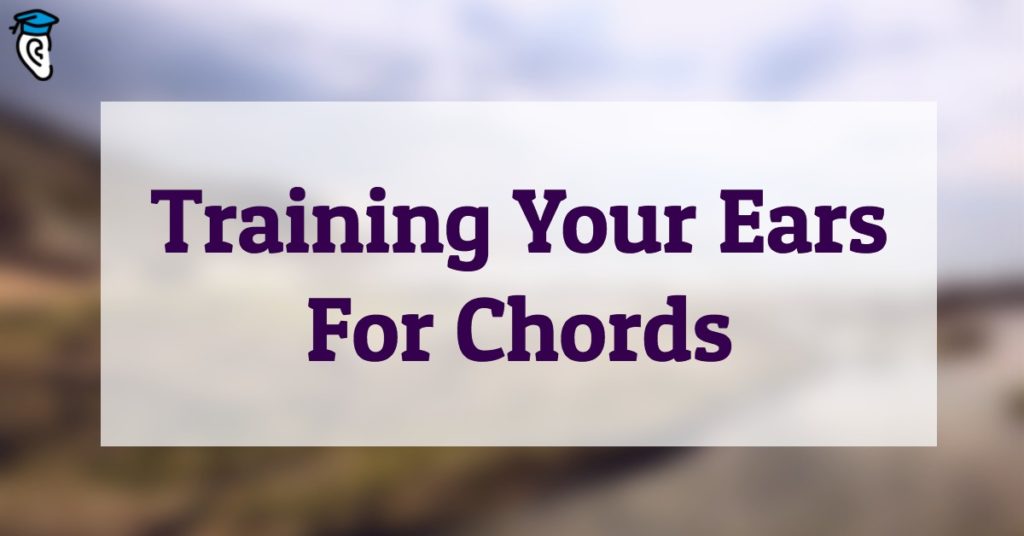Isn’t it magical when someone sits down at the piano or picks up the guitar and seems to know how to play every song by ear? It’s not magic – these musicians have spent some time learning the identify chords and chord progressions. Would you like to learn how to do that, too? With a little chord ear training, being able to play any song by ear is well within your grasp.
Even if you play an instrument that can’t voice chords, such as trumpet or singing, learning to recognize chords and chord progressions is essential ear training for any musician as it helps you to identify what is happening in the harmony of a song.
This is a summary post.
→ Read the full guide
What is a chord?
Chords are created when three or more notes are sounded at the same time. The notes of a chord are stacked in a certain order and are identified as follows:
- The bottom note is called the “root” and gives the chord its name.
- The “third” appears above the root at the interval of a major or minor third.
- The “fifth” appears above the root at the interval of a fifth (or a third above the root), and so on.
Although the chord is built by stacking notes a certain way like this, the notes of a chord can actually be shuffled and appear in any order, without changing the identity of the chord. These alternative forms are called “inverted” chords.
Start with The Triad
When learning to identify chords and chord progressions by ear, start by learning to identify simple chords and then build from there. There are two types of chords to consider – three-note and four-note – but you ought to learn to first identify three-note chords, also called “triads”.
When beginning your chord ear training, listen to three-note chords in root position (meaning the root note is at the bottom) because it’s harder to pick out the root of an inverted chord.
After you mastering three-note chords, you can move onto learning to identify inversions, four-note chords like seventh chords…and beyond! With a good grounding in three-note chord recognition, it will be easier to identify these more complex chords later on and also serves as the foundation for recognizing chord progressions.
Identifying Major and Minor Triads
There are four main types of the basic three-note chords, known as “triads”. The two primary triad “flavors” are “major” and “minor” and are the foundation for the vast majority of the harmonies we hear. Basically, major triads tend to have a “sunny” sound, while minor triads sound more “serious”. Learning to tell them apart is the beginning of all your chord ear training.
The other two main triad types – “diminished” and “augmented” – are not quite as common, but once you learn to identify them they open up new possibilities for composing and prepare you for even more advanced chords.
Chord Relationships
Chord progression ear training is about hearing the relationships between the chords in a piece of music. To begin chord progression ear training, listen first to cadences (two-chord progressions), then to three and four-chord progressions.
To identify how chords relate to one another, music theory uses Roman numerals: I (= 1), IV (= 4), V (= 5) etc., so that is how you will read chord progressions. The two most recognizable chord cadences are V-I (“authentic”) and IV-I (“Plagal” / “Amen”).
When listening to cadences, try picking out the root notes of the chords and listen to how each chord moves and resolves to the next. Identifying the movement of the root note is a great opportunity to apply your knowledge of intervals.
Training only on combinations of the I, IV, and V chords (e.g. IV-I or V-I cadences, I-IV-V and I-V-IV-V) puts a world of music within your grasp. These basic chord progressions serve as the building blocks of much more complex progressions, which have more than three chords. The next chord to add to our toolkit of chord progressions is the vi minor chord. Just like three-chord songs, four chord songs (using the I, IV, V and vi chords) are everywhere in music!
Start training your ears for chords
Chord ear training serves to remove to blur of harmony to clearly reveal the role that each note has to play in music. With regular practice, you will experience more enjoyment of music because you have a better understanding of what’s happening.
With chord ear training, you will also have new-found skills in playing songs by ear, improvisation, and interacting musically with others. Why not invite a few friends along on your chord ear training journey?







